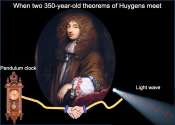Speed of light drops to zero at 'exceptional points'
Light, which travels at a speed of 300,000 km/sec in a vacuum, can be slowed down and even stopped completely by methods that involve trapping the light inside crystals or ultracold clouds of atoms. Now in a new study, researchers ...









